The Armata Festival and the Allure of Spetses...
Experience Spetses in its most enchanting...
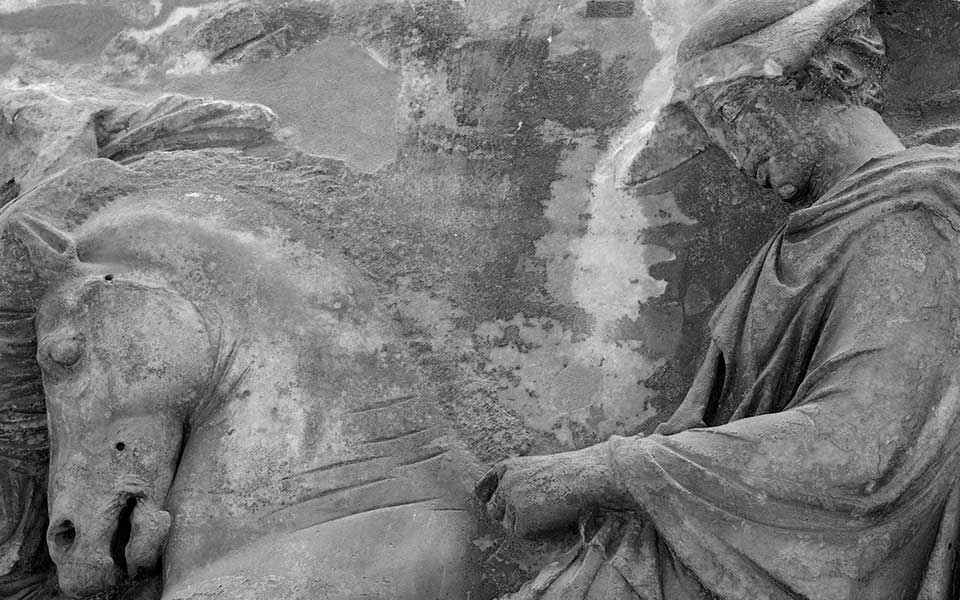
The Rampin Rider (about 550 BC).
© Dimitris Tsoumplekas
The Acropolis Museum recently marked fifteen years since opening its doors to the public on June 20, 2009. To celebrate this great anniversary, we think the Acropolis Museum deserves a birthday party, so we’re inviting some of the “residents” who inhabit their galleries to be guests at this fabulous event. They’ve all promised to tell us a little about themselves and the museum’s remarkable achievements during its rise to becoming one of the world’s premier museum experiences.
Within the Acropolis Museum’s intriguingly experiential design, mimicking a visitor’s ascent up the actual Acropolis, the brides of Archaic/Classical Athens and their votive amphorae (6th/5th century BC) are among the first displays we encounter. Since they’re already in a festive mood, they’re the first to be invited! One bride tells us, “We dedicated these elaborately painted ῾loutrophoroi’ as offerings at the sanctuary of Nymphe, protector of wedding ceremonies and marriage, on the South Slope of the Acropolis. Before the wedding, our friends also used these vessels to carry water for our prenuptial bath. You can see all the different stages in our marriage ritual on the loutrophoroi themselves. The next day, after donning our best clothes and receiving crowns, we had more traditions to follow, as did the groom. Our fathers invited everyone to an evening symposium. Only at the end of this banquet did we lower our veils and reveal ourselves to our husband. Then we were carried off to our new home on a wagon, followed by a parade of relatives and friends waving torches, singing, and playing lyres and flutes. The following morning, we received our wedding gifts, and our fathers presented us our dowries.”
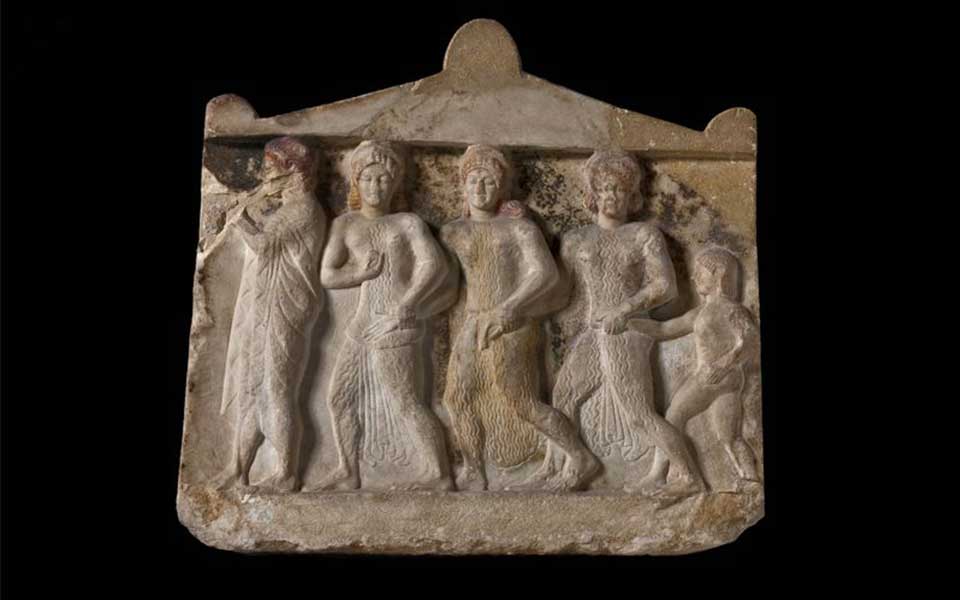
The “Relief of the Graces” (500-490 BC)
© Acropolis Museum
What would a birthday party be without dancers and musicians? The three ladies of the “Relief of the Graces” (500-490 BC), with their Archaic-style smiles and “almond eyes,” also appear ready for a celebration as they parade behind Hermes playing a flute. “We may be ‘graceful,’” one jestingly whispers, “but some people think we’re actually the daughters of Cecrops, the legendary king of Athens; in that case, this young man behind us would be our brother Erysichthon.” In another votive plaque (2nd century BC), more dancers join us. Hermes stands, one foot up on a rock, listening to Pan piping away while Apollo rests on his lyre. One of the three delicately-robed dancers behind Hermes fills us in: “Mythical folk had small shrines all around the Acropolis, but we are nymphs, worshiped together with Pan and Hermes on the South Slope near Asclepius’ sanctuary and sacred spring. That’s where this dedicatory relief was offered to us all!”
And now here is our most dramatic dancer – one of the Horae (late 1st century BC), with wildly flowing carved garments. She once enlivened the pedestal of a choragic victory monument, erected on the Street of the Tripods.
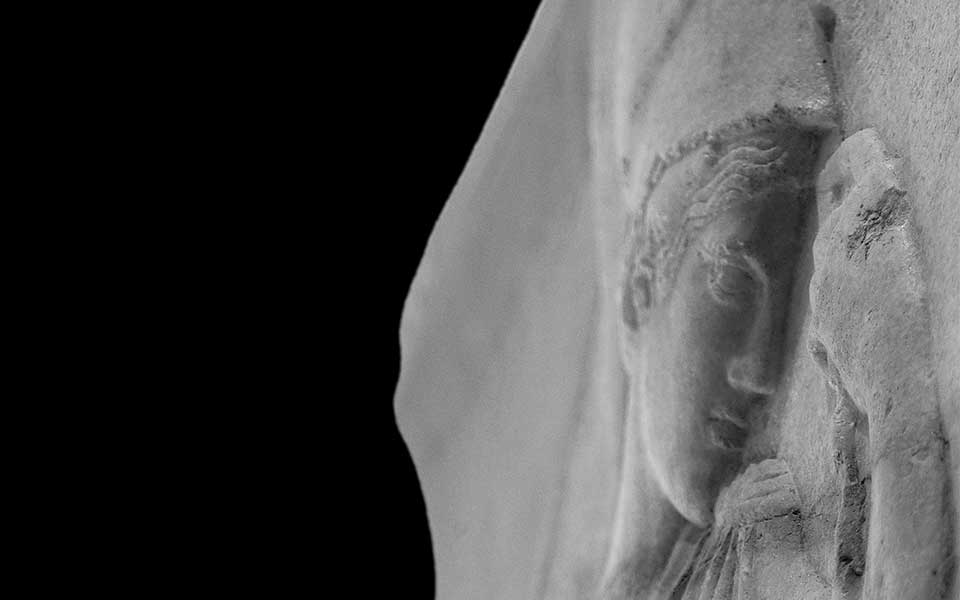
Pensive Athena
© Dimitris Tsoumplekas
Our party’s guest of honor should, of course, be Athena herself – the divine protectress of the city of Athens, and the main deity to whom the sanctuary on top of the Acropolis was dedicated. After all, without this wise warrior goddess, would there have been a militarily supreme Athenian city-state? Would the Greeks have managed to defeat the invading Persians? Would Athens have ever become a center of philosophy and learning? Would the magnificent marble buildings of Pericles’ building program on the Acropolis have been constructed, or the gleaming bronze and chryselephantine statues of Athena Promachos and Athena Parthenos by Phidias been created? And if all that hadn’t happened, would there even have been a need for the Acropolis Museum?
“Not likely,” says the Severe-style “Pensive Athena” (460 BC), as she coolly leans on her spear beside a stele, variously identified as a boundary marker, a treasury archive, or an inscribed list of Athenians fallen in battle. Although she appears calm, her enormous power held in quiet reserve, the warrior goddess is still clearly a force to be reckoned with, just as the Acropolis Museum has come to be over the past fifteen years.
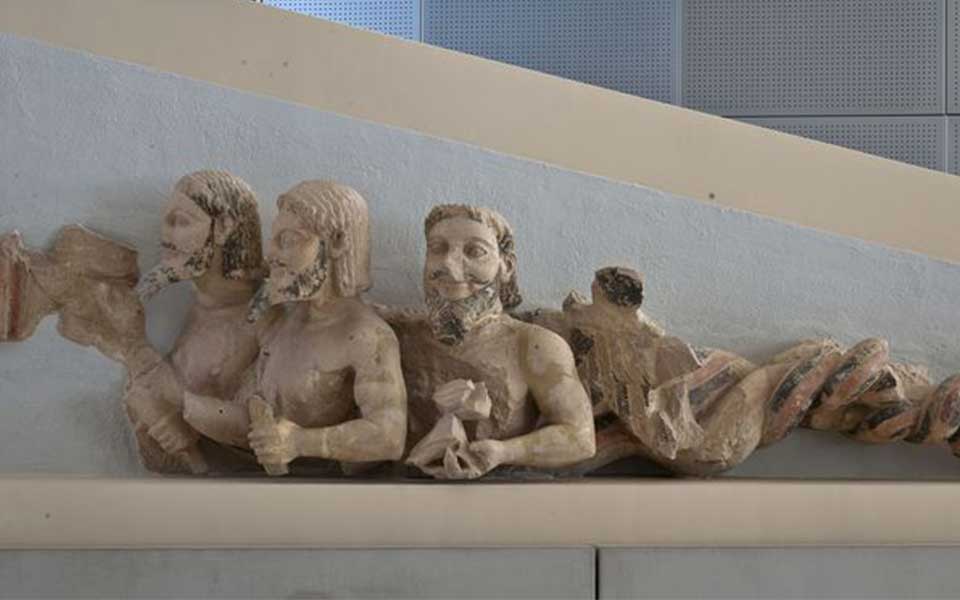
The Three-Bodied Daemon
© Acropolis Museum
At the beginning of the Acropolis Museum’s Archaic Gallery stands the distinctive, action-filled pediment of the Hekatompedon, known as the “Archaic Parthenon.” Among its sculptures (about 570 BC) is the unique “three-bodied Daemon,” a winged, snake-like creature whose three human heads with smiling faces suggest they, too, would be pleased to attend the AM’s birthday party. “The archaeologists dubbed us ‘Bluebeard’ when they dug us up in 1888,” the right-hand figure relates, “and we like that name. It makes us feel like pirates! However, we have a more serious job, as we represent the natural world of the Athenians. My brothers hold a wave and a flame, while I have a bird; together, we symbolize water, fire, and air. Our entwined serpent bodies also signify the Earth, from which the Athenians believed their legendary king Erechtheus was born as a half-man, half-snake being. (Later, he was adopted by Athena, built her a temple on the Acropolis, sided with her over Poseidon in their contest, and established the Panathenaia festival in her honor.) But who are we really? Some say we’re Nereus, the shape-shifting rival of Herakles. Wouldn’t our powers make an entertaining party trick, if we suddenly transformed ourselves into the natural elements…?”
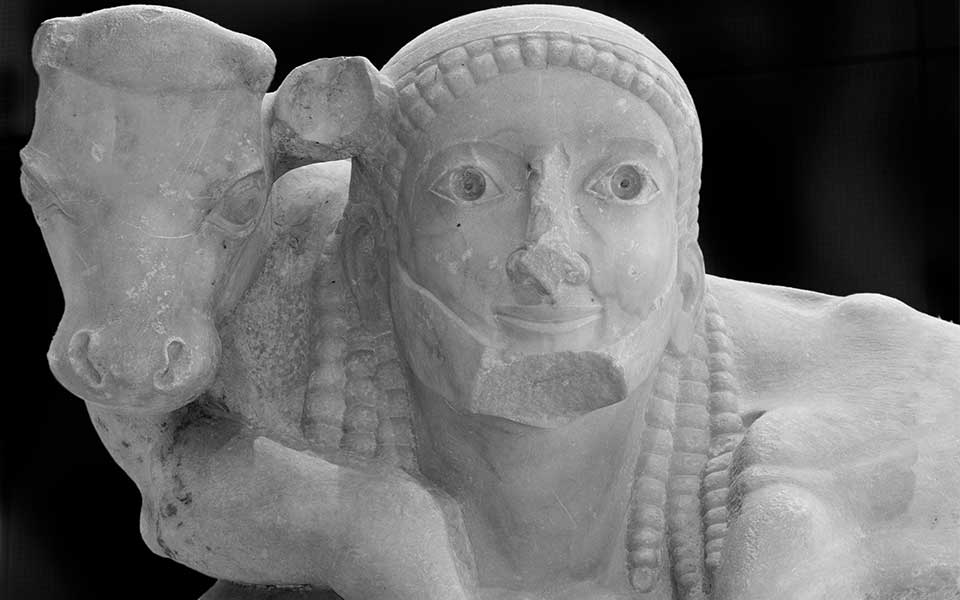
The Calf-Bearer
© Dimitris Tsoumplekas
If we’re throwing a birthday party, someone needs to bring gifts. Behold, here comes the Calf-Bearer (about 570 BC)! And the Hydriaphoroi from the Parthenon’s Ionic frieze (442-438 BC), carrying jars of water to sprinkle on the altar and the sacrificial animals. To make our celebration a proper Athenian rite, we surely need to offer a sacrifice! And the Acropolis Museum must have an altar or two we can borrow. Ancient visitors to the Acropolis regularly came bearing gifts – from figurines and miniature vessels to large bronze and marble sculptures – which they dedicated to Athena to show their reverence and their gratitude. The Acropolis itself must have looked something like a museum, with all its standing statuary and identifying inscriptions. “I am Rhombos, son of Palos,” the Calf-Bearer now confides to us. “I paid for this votive offering and had it made from marble quarried on Mt Hymettus. When the Attic sculpture workshops opened in the early 6th century BC, I was one of their first customers. The aristocratic citizens of my class, the Pentakosiomedimnoi, could afford such lavish dedications, as every year we produced at least 500 Attic medimnoi (about 52 liters) of goods such as olive oil or grain.”
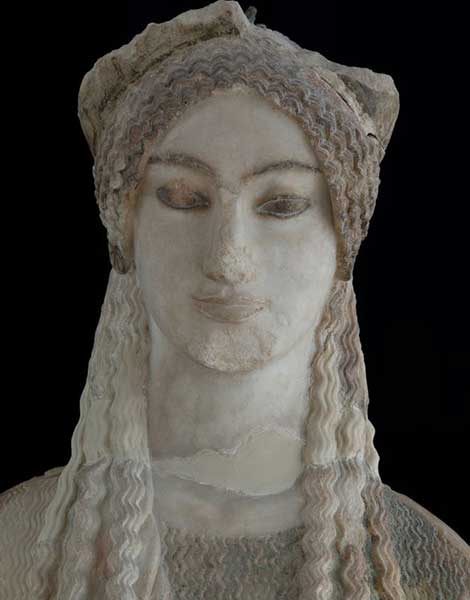
The Kore with Almond Eyes
© Acropolis Museum
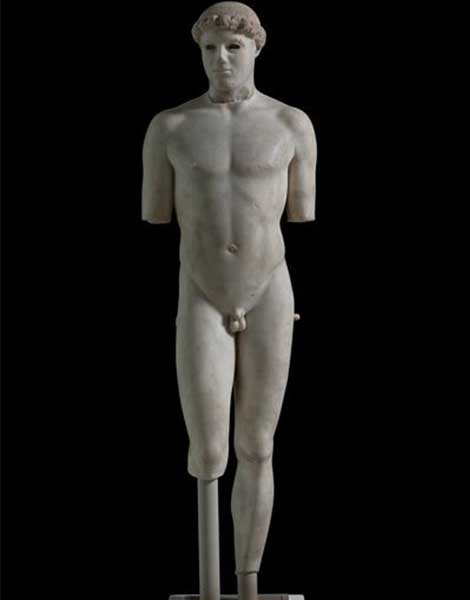
The Kritios Boy
© Acropolis Museum
We can also fill our guest list with stylish Athenian women and men. There are always plenty of those hanging about the Acropolis Museum. Particularly appealing are the Kore with Almond Eyes (500 BC) and her eloquently coiffed younger “sister” (490 BC), whose quiet smile and more naturalistic eyes reveal her to be a thoughtful, well-mannered lady of means. These are just some of the many dedicatory korai figures from the Acropolis, whose ornate garments – here, a chiton and outer himation – fall in finely carved folds. “Yes,” Almond Eyes tells us, “my sister is beautiful, and I’ve always wanted her earrings, but you have no idea how stunning we used to be when sporting our original paint!”
In fact, we do, thanks to the AM’s conservation laboratory, where scientists have successfully preserved and recreated the exact pigments used by the sculptors. “We’re all a bit envious of our friend the Chios Kore (510 BC),” Almond continues; “just look at her blonde hair, perfect make-up, and exquisite robes!” Besides each other, the ladies are also eyeing our male guests – the well-groomed Rampin Rider (about 550 BC) and the handsome Kritios Boy (about 480 BC) who, appropriately enough for today, is wearing nothing but his birthday suit!
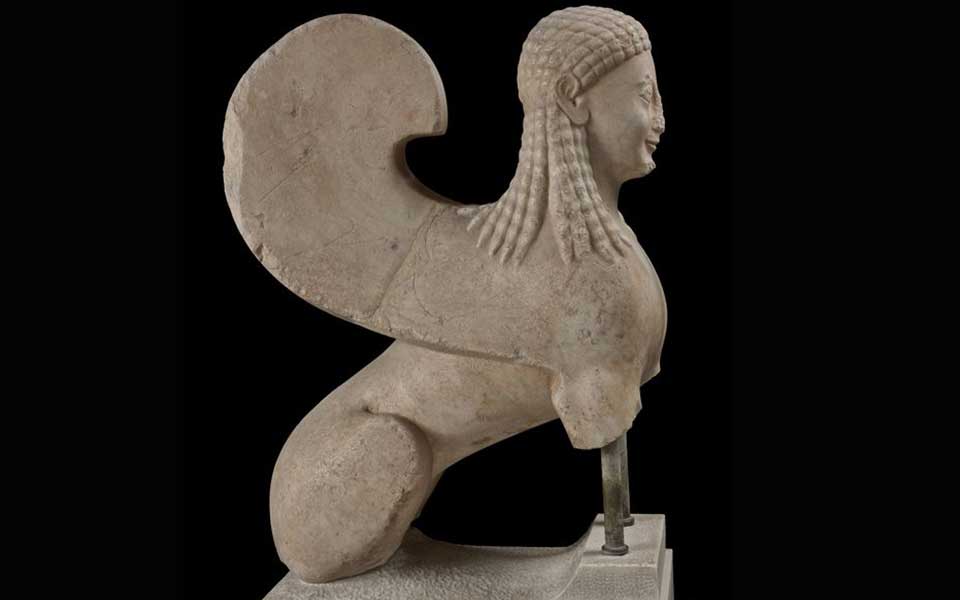
The Marble Sphinx (540-530 BC)
© Acropolis Museum
To keep bad luck away from our party, we’ll also invite the Marble Sphinx (540-530 BC). She may be smiling, but beware! These apotropaic daemonic creatures were powerful beasts associated with the underworld. They had the head of a woman, a lion’s body, an eagle’s wings, and a snake-like tail. Such imaginary figures were a common sight in Athena’s Acropolis sanctuary, as well as in other important places. “Remember the Naxian Sphinx (560 BC),” our own sphinx reminds us, “which stood on a ten-meter-high Ionic column in front of the Temple of Apollo at Delphi. I am exceptional, however, like so many of the Acropolis Museum’s sculptural masterpieces, because my wings are innovatively shown beside my head, not behind it. My stylized hair, almond-shaped eyes, and pinched smile all identify me as a work of the 6th century BC. That’s when I was carried up to the Acropolis as a votive offering.” Sphinxes also featured on painted vases of the Orientalizing period (8th-7th c. BC), such as those from Corinth, when artistic influences entered Greece from Egypt and other eastern areas. Ultimately, however, they didn’t keep those pesky Persians away from the Acropolis!
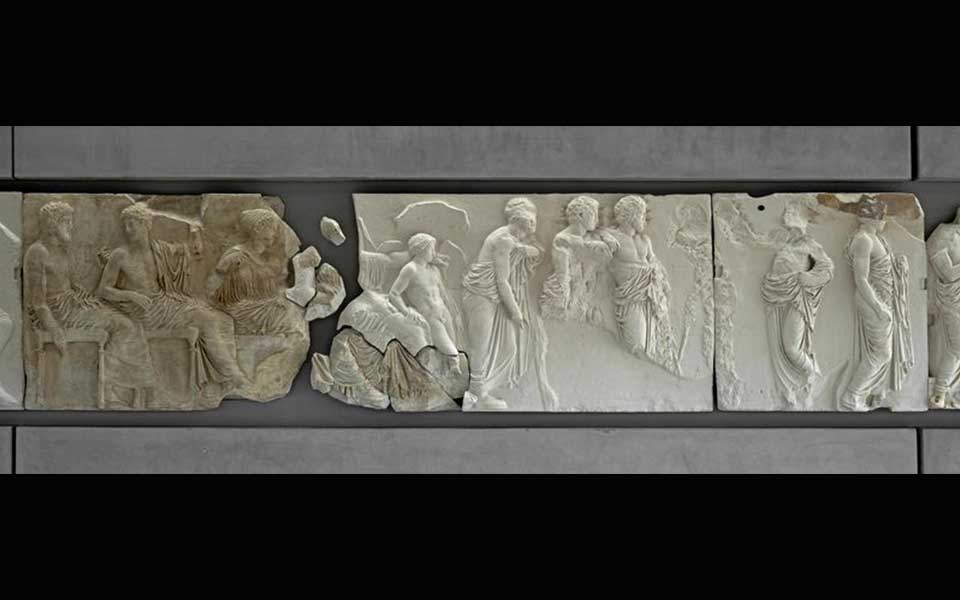
The Olympian gods on Block VI of the Ionic frieze from the Parthenon’s east side.
© Acropolis Museum
One of the great missions of the Acropolis Museum is to bring all the scattered fragments of the Parthenon and other Acropolis monuments back home to be reunited in Athens. In keeping with this, the Olympian gods on Block VI of the Ionic frieze from the Parthenon’s east side should also be invited to the AM’s party; two fragments from this sculpted panel are now in the British Museum in London while another remains in Palermo.
Poseidon ranks especially high among our VIP guests, as he was one of the three main figures worshiped on the Acropolis in ancient times, the others being Athena and Erechtheus. “Don’t forget,” Poseidon rumbles at us, “Athena and I competed to become the Athenians’ divine protector – an unfortunate affair that those cheeky mortals commemorated on the Parthenon’s west pediment. Yes, I lost to my shrewd, olive-tree-gifting niece, but I still remained an almighty god for Athens and its navy. My cult was merged with that of Erechtheus, but I had my own shrine inside the Erechtheion.” Artemis Brauronia, too, had a small sanctuary within Athena’s larger Acropolis precinct, while Apollo, Aphrodite, and Eros were worshiped below in small cave shrines on the north slope of the Sacred Rock.
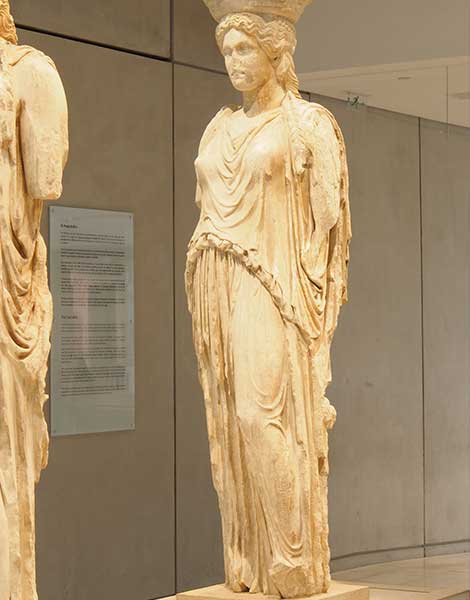
The Caryatids
© Dimitris Tsoumplekas
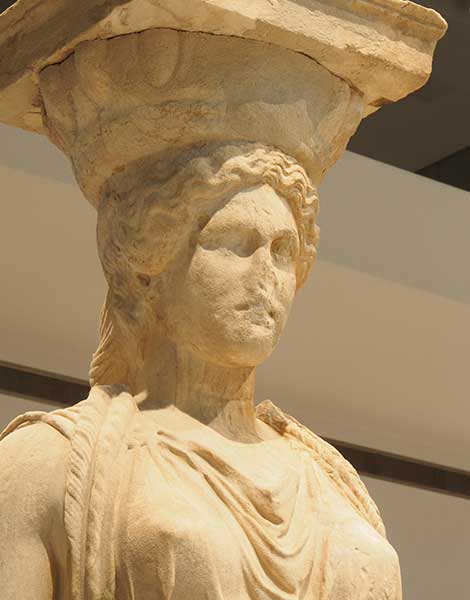
The Caryatids
© Dimitris Tsoumplekas
Among the greatest personalities of the Acropolis are the Caryatids (420-415 BC), whose composure, beauty, and devotion to their duties have always been inspiring. They once processed in rhythmic unison around the Erechtheion’s South Porch, gazing toward the Parthenon and creating a visual link between these two key Acropolis monuments. Like these load-bearing ladies, who also acted as elegant columns, the Acropolis Museum carries its own heavy responsibility for the safeguarding and promotion of the Acropolis’ movable treasures. Who are these impressive women? “Some say we came from Persia,” one Caryatid tells us, “but in fact we just liked the Achaemenid styles that were filtering into Classical Athens from that dynamic center of artistic fashion, Persepolis. We’re actually aristocratic Athenian women who served as attendants in the worship of Cecrops, Athens’ legendary king, whose tomb is supposed to lie beneath our little porch.” Another Caryatid pulls us aside conspiratorially: “I know what we should do! Let’s invite our long-lost sister in London to attend your party. We all miss her so much! After Elgin took her away, the Athenians used to complain about our loud weeping. And if she comes, wouldn’t that be a great birthday present for the Acropolis Museum?”
Last but not least, we’ll ask Zeus, the king of the Olympian gods, to join us. Here he is now, as youthful Zeus Heliopolitanus (late 1st century AD). His sculpted image was unearthed in Well 39 of the Roman-era residence “House Ξ” during the archaeological investigation of the Makriyiannis plot, prior to the construction of the new Acropolis Museum. He proudly shows off his tunic emblazoned with personifications of the seven known planets in the ancient geocentric cosmos, pointing out each figure to us: “Kronos (Saturn); me, of course (Zeus/Jupiter), here with Hera (instead of Aphrodite/Venus); Helios (Sun); Selene (Moon); Ares (Mars); and Hermes (Mercury).”
To tell the truth, we’re quite impressed with this Zeus, since this unusual depiction of the master of the heavens is the first example of this statue type ever discovered in Greece. “I’m actually a long way from home,” the god concedes, “as I have traveled all the way from Heliopolis in Syria…” His Asian origins remind us of the vast expansion of the Hellenistic Greek and succeeding Roman worlds, when the cultural influences of West and East blended and flowed in all directions. That’s how it is, though, isn’t it? The best parties bring all kinds of different people together. Now, to complete this birthday tribute to the Acropolis Museum, let’s follow that timeless Greek and Roman tradition we all still love… Bring on the sacred cake!
Experience Spetses in its most enchanting...
A guided journey across Athens’ storied...
Renewed negotiations, shifting public opinion and...
Tourists share the highs and lows...